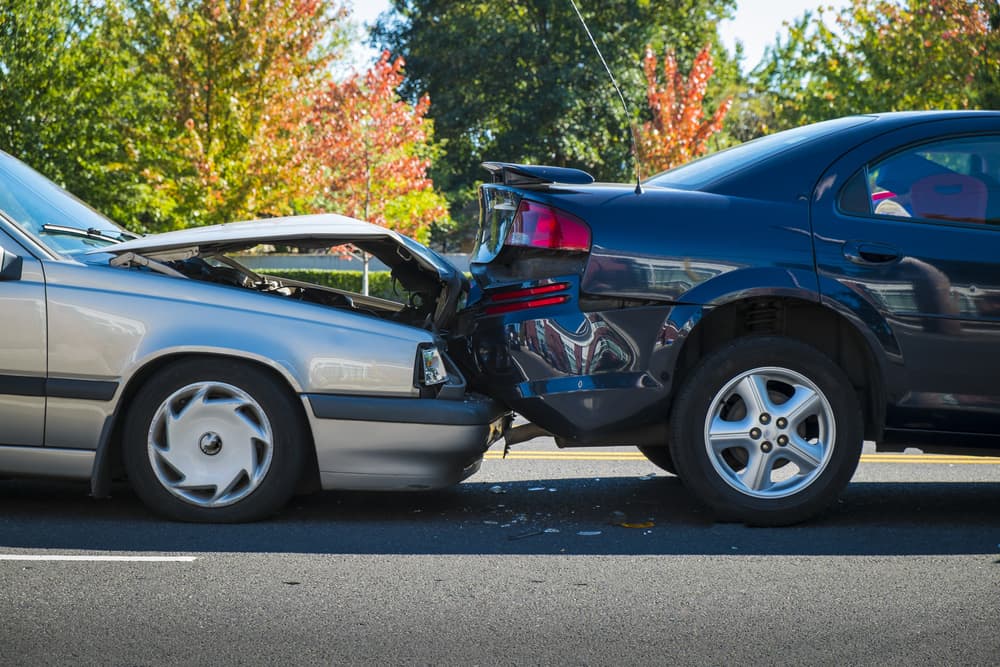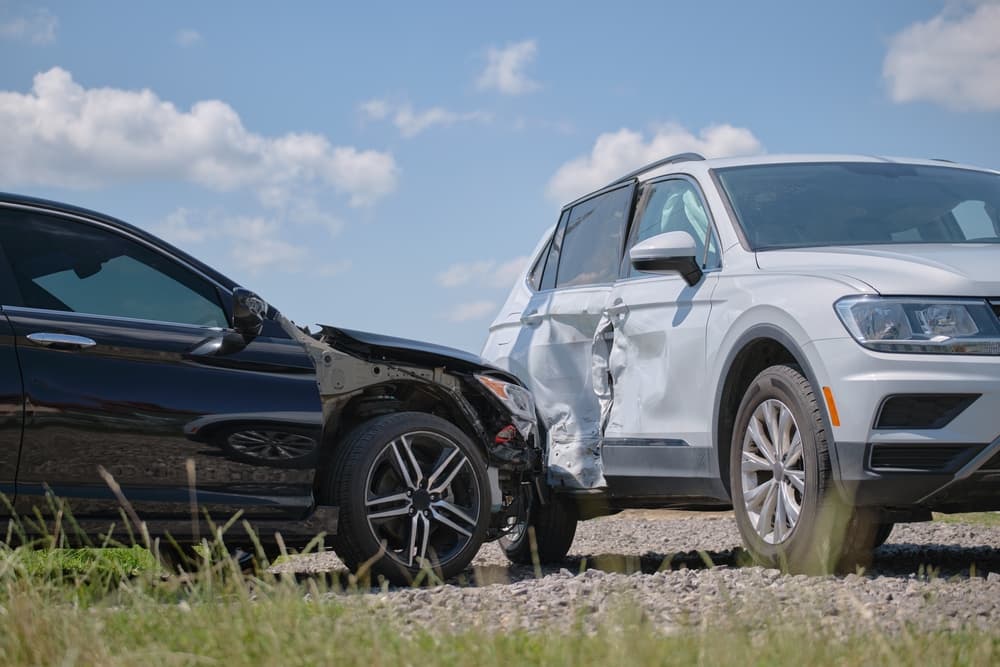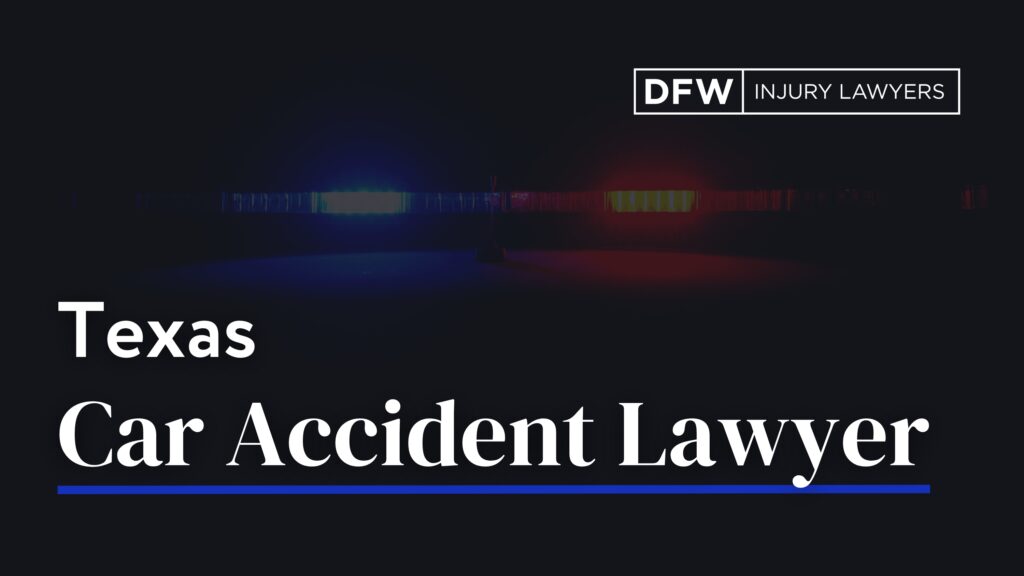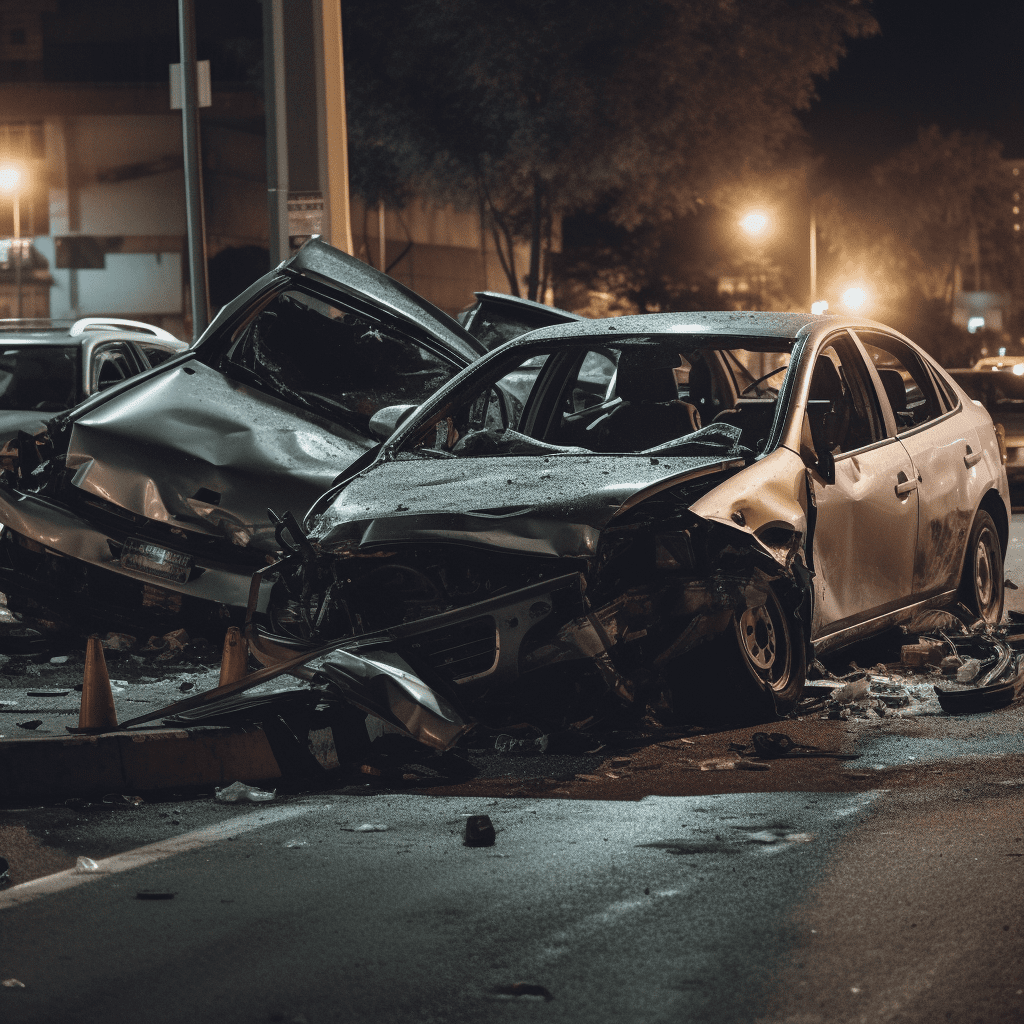Listen to an excerpt of this page
Car accidents are a sobering reality in our fast-paced, modern world. Every time we get behind the wheel, we face the possibility of being in a crash. In the United States alone, millions of vehicles traverse the roads and highways daily, and with so many drivers, distractions, and potential hazards, accidents are unfortunately inevitable.
The consequences of car accidents can be life-altering, ranging from minor vehicle damage to severe injuries or even fatalities. In this blog, we’ll delve into the most common types of car accidents, their potential consequences, and how our experienced team of car accident lawyers can navigate the complex legal process and fight for the compensation you deserve.
Key Takeaways
- Car accidents are common, with rear-end collisions, T-bone accidents, and head-on collisions being major types.
- Each type of accident has distinct causes and injury patterns, highlighting the importance of cautious driving.
- Seeking legal counsel after an accident is crucial for navigating the complex aftermath and securing rightful compensation.
Common Types of Car Accidents
Here are five of the most common types of car accidents our personal injury lawyers have seen:
1. Rear-End Collisions
Rear-end collisions are one of the most common types of car accidents, accounting for a significant portion of crashes on our roads. These accidents occur when the front of one vehicle collides with the rear of another vehicle, often resulting in a jarring impact that can cause serious injuries and property damage.
There are several common causes of rear-end collisions:
- Following too closely (tailgating): When drivers fail to maintain a safe distance from the vehicle in front of them, they may not have enough time to react and stop if the leading vehicle suddenly slows down or brakes.
- Distracted driving: Drivers texting, eating, adjusting the radio, or engaging in other distracting activities may not notice when the vehicle ahead of them slows down or stops, increasing the risk of a rear-end collision.
- Speeding: Excessive speed reduces a driver’s ability to react quickly and safely to changes in traffic, making it more difficult to avoid a rear-end collision.
- Poor weather conditions: Rain, snow, ice, and fog can make it harder for drivers to see and stop in time, increasing the likelihood of rear-end accidents.
- Faulty brakes: Improperly maintained or faulty brakes may prevent the driver from stopping in time to avoid a rear-end collision.
Rear-end collisions can cause a wide range of injuries, depending on the speed of the vehicles involved and the severity of the impact.
Some common injuries associated with rear-end accidents include:
- Whiplash: This neck injury occurs when the head is suddenly thrown forward and then snapped back due to the force of the impact. Whiplash can cause neck pain, stiffness, headaches, and limited range of motion.
- Back injuries: The force of a rear-end collision can cause herniated discs, spinal cord damage, or other back injuries that can result in chronic pain and limited mobility.
- Head injuries: If the impact is severe enough, occupants may hit their heads on the steering wheel, dashboard, or windows, resulting in concussions, skull fractures, or traumatic brain injuries.
- Facial injuries: Shattered glass, airbag deployment, or loose objects in the vehicle can cause cuts, bruises, or fractures to the face.
- Soft tissue injuries: The sudden impact can cause sprains, strains, and tears to muscles, ligaments, and tendons throughout the body.


2. T-Bone Accidents
T-bone accidents, also known as side-impact collisions or broadside collisions, are a dangerous type of car accident that occurs when the front of one vehicle crashes into the side of another vehicle, forming a “T” shape at the point of impact.
The side of a car offers less protection to occupants compared to the front or rear, making these accidents can be particularly devastating.
Common causes of T-bone accidents include:
- Running a red light or stop sign: When a driver fails to obey traffic signals or signs and enters an intersection without the right of way, they may collide with a vehicle traveling through the intersection from a perpendicular direction.
- Failure to yield: T-bone accidents can occur when a driver fails to yield to oncoming traffic when turning left or entering a roadway from a side street or driveway.
- Distracted driving: Drivers who are not paying attention to the road may fail to notice traffic signals, signs, or other vehicles entering an intersection, increasing the risk of a T-bone collision.
- Speeding: Excessive speed can make it difficult for drivers to react in time to avoid a collision, particularly when approaching an intersection.
- Impaired driving: Drivers under the influence of drugs or alcohol may have impaired judgment, reaction times, and decision-making abilities, making them more likely to cause a T-bone accident.
T-bone accidents can result in severe injuries, particularly for occupants seated on the side of the vehicle that is struck.
Some common injuries associated with side-impact collisions include:
- Head and neck injuries: The sudden, violent motion of a T-bone collision can cause occupants’ heads to strike the window, door frame, or other objects, resulting in concussions, skull fractures, or whiplash.
- Chest and abdominal injuries: The force of the impact can cause broken ribs, punctured lungs, or internal organ damage.
- Pelvic and leg injuries: Occupants seated on the side of the vehicle that is struck may suffer fractures to the pelvis, femur, or other bones in the legs.
- Spinal cord injuries: Severe T-bone accidents can cause damage to the spinal cord, potentially resulting in paralysis or other permanent disabilities.
- Lacerations and bruises: Broken glass, metal fragments, and other debris can cause cuts, scrapes, and bruises to occupants’ skin.
3. Head-On Collisions
Head-on collisions are one of the most severe types of car accidents, often resulting in catastrophic injuries or fatalities. These accidents occur when the front ends of two vehicles collide, exerting tremendous force on the vehicles and their occupants.
Common causes of head-on collisions include:
- Wrong-way driving: Head-on collisions can occur when a driver enters a highway or road going the wrong direction, often due to confusion, impairment, or poor visibility.
- Crossing the centerline: When drivers fail to maintain their lane and cross into oncoming traffic, they risk causing a head-on collision. This can happen due to distracted driving, falling asleep at the wheel, or losing control of the vehicle.
- Overtaking and passing: Attempting to pass another vehicle on a two-lane road without sufficient space or visibility can lead to a head-on collision with oncoming traffic.
- Impaired driving: Drivers under the influence of drugs or alcohol may have impaired judgment, reaction times, and control over their vehicles, increasing the risk of swerving into oncoming traffic and causing a head-on collision.
- Poor weather conditions: Rain, snow, ice, or fog can make it difficult for drivers to see and maintain control of their vehicles, potentially leading to head-on collisions.
Head-on collisions can result in devastating injuries due to the combined speed and force of the two vehicles involved. Often, these accidents result in fatalities.
Some common injuries associated with head-on collisions include:
- Traumatic brain injuries (TBI): The sudden deceleration and impact can cause occupants’ brains to collide with the inside of their skulls, resulting in concussions, contusions, or more severe brain damage.
- Spinal cord injuries: The force of the collision can cause damage to the spinal cord, potentially leading to paralysis, loss of sensation, or other permanent disabilities.
- Broken bones: The impact can cause fractures to the legs, arms, ribs, pelvis, or other bones throughout the body.
- Internal injuries: The force of the collision can cause damage to internal organs, such as the lungs, liver, spleen, or kidneys, which can be life-threatening if not treated promptly.
- Facial injuries: Occupants may suffer broken facial bones, eye injuries, or dental trauma from striking the steering wheel, dashboard, or other objects in the vehicle.


4. Sideswipe Accidents
Sideswipe accidents occur when two vehicles traveling in the same direction collide, with the side of one vehicle striking the side of the other. While these accidents may seem less severe than other types of collisions, they can still cause significant damage and injuries to those involved.
Common causes of sideswipe accidents include:
- Improper lane changes: Sideswipe accidents often occur when a driver fails to check their blind spot or signal before changing lanes, causing them to collide with a vehicle in the adjacent lane.
- Distracted driving: Drivers who are texting, eating, or otherwise not paying attention to the road may drift out of their lane and sideswipe another vehicle.
- Merging errors: Sideswipe accidents can happen when a driver misjudges the space available while merging onto a highway or into another lane, causing them to collide with a vehicle already occupying that lane.
- Speeding: Excessive speed can make it more difficult for drivers to maintain control of their vehicles and stay within their lanes, increasing the risk of sideswipe accidents.
- Impaired driving: Drivers under the influence of drugs or alcohol may have impaired judgment, reaction times, and ability to maintain their lane, making them more likely to sideswipe other vehicles.
While sideswipe accidents may not always involve the same level of force as other types of collisions, they can still cause a range of injuries, such as:
- Whiplash: The sudden, sideways motion of a sideswipe accident can cause occupants’ heads and necks to jerk abruptly, resulting in whiplash injuries.
- Soft tissue injuries: The impact can cause sprains, strains, or tears to muscles, ligaments, and tendons in the neck, back, or other body parts.
- Broken bones: In more severe sideswipe accidents, occupants may suffer fractures to the arms, legs, or other bones, particularly if the impact causes the vehicle to spin or roll over.
- Lacerations and bruises: Broken glass, loose objects, or contact with the vehicle’s interior can cause cuts, scrapes, and bruises to occupants’ skin.
The legal muscle you need to win
5. Single-Vehicle Accidents
Single-vehicle accidents, as the name suggests, involve only one vehicle but can result in serious injuries or fatalities.
Common causes of single-vehicle accidents include:
- Distracted driving: Drivers who text, eat, or otherwise don’t pay attention to the road may veer off the roadway, strike a fixed object, or lose control of their vehicle.
- Speeding: Excessive speed can make it more difficult for drivers to navigate curves, maintain control on slippery roads, or stop in time to avoid obstacles.
- Impaired driving: Drivers under the influence of drugs or alcohol may have impaired judgment, reaction times, and ability to operate their vehicles safely, increasing the risk of single-vehicle accidents.
- Fatigue: Drowsy driving can be just as dangerous as impaired driving, as fatigued drivers may fall asleep at the wheel, drift out of their lane, or fail to react to hazards in time.
- Poor road conditions: Potholes, debris, or inadequate signage can contribute to single-vehicle accidents, particularly if drivers are not able to safely navigate these hazards.
- Vehicle malfunctions: Mechanical issues such as tire blowouts, brake failures, or steering problems can cause drivers to lose control of their vehicles and result in single-vehicle crashes.
- Animal collisions: Drivers who swerve to avoid animals on the road may lose control of their vehicles, leading to single-vehicle accidents.
Single-vehicle accidents can result in a range of injuries, depending on the speed of the vehicle, the point of impact, and whether the occupants were wearing seat belts.
Some common injuries associated with single-vehicle accidents include:
- Head and brain injuries: Occupants may suffer concussions, skull fractures, or more severe traumatic brain injuries if their heads strike the steering wheel, dashboard, or windows during the crash.
- Spinal cord injuries: The force of the impact can cause damage to the spinal cord, potentially resulting in paralysis or other permanent disabilities.
- Broken bones: Fractures to the arms, legs, ribs, or other bones can occur due to the force of the impact or contact with the vehicle’s interior.
- Soft tissue injuries: Whiplash, sprains, and strains to the neck, back, or other parts of the body can result from the sudden, violent motion of a single-vehicle crash.
- Lacerations and bruises: Broken glass, loose objects, or contact with the vehicle’s interior can cause cuts, scrapes, and bruises to occupants’ skin.

Contact a Car Accident Lawyer You Can Trust
If you or a loved one suffered injuries in any type of car accident, it’s essential to seek legal guidance from a skilled personal injury lawyer.
At DFW Injury Lawyers, our team has the knowledge and experience to handle all types of car accident cases. We understand the physical, emotional, and financial toll a crash can take on your life, and we’re here to help you every step of the way.
Don’t hesitate to reach out to us for a free consultation. We’ll review your case, answer your questions, and advise you on the best course of action. With DFW Injury Lawyers on your side, you can focus on your recovery while we fight for the compensation you deserve.
Call us today at (972) 440-2320 or through our online form for your free and confidential consultation.



